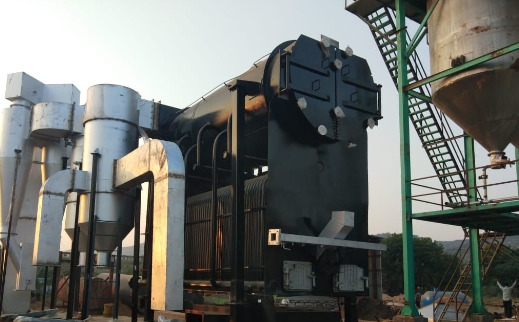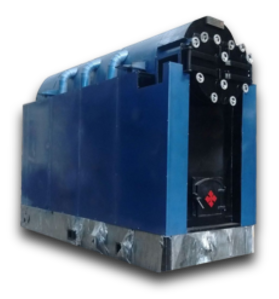#rice processing
Explore tagged Tumblr posts
Text
Rice Processing: Key Innovations Shaping the Future of the Industry
Rice is a fundamental staple for millions of people worldwide, and ensuring its quality and efficiency in processing is crucial. The rice processing industry has evolved significantly over the years, with innovative technologies playing a pivotal role. APIT (Agri Process Innovations & Technologies) is leading the charge in transforming rice and grain processing with advanced solutions that improve quality, efficiency, and sustainability. In this blog, we’ll explore five key innovations that are shaping the future of rice processing.
1. Continuous Parboiling: A Game-Changer in Rice Processing
One of the most significant advancements in rice processing is continuous parboiling. Unlike traditional batch parboiling, which involves soaking, steaming, and drying rice in stages, continuous parboiling allows these steps to happen simultaneously in a continuous flow. This results in uniform rice with improved nutritional value, color, and texture.
APIT’s continuous rice parboiling systems help rice mills boost efficiency by reducing processing time and minimizing the risk of errors. The consistency in the final product also makes it easier for mills to meet the growing demand for high-quality rice. Continuous parboiling is not just about speed but also about maintaining high-quality standards throughout the production process.
2. The Importance of Automated Paddy Processing
Automated paddy processing is another breakthrough that is elevating rice production. Traditional rice milling often depends on manual labor, which can lead to inconsistencies in the quality of the rice. With automation, each step in the processing line—from cleaning and sorting to milling—is done with greater precision, ensuring consistent results.
APIT’s automated systems improve both the quantity and quality of rice produced. By eliminating human errors and maintaining high standards in every phase, automated processing results in fewer broken grains and more uniform rice. Automation also enhances productivity, reduces labor costs, and increases overall efficiency in rice mills.
3. Super Ageing Technology: Enhancing Quality and Shelf Life
Super ageing technology is revolutionizing how rice is processed for better taste, texture, and longevity. The process involves aging rice under controlled conditions, which improves its cooking properties and flavor. Super-aged rice tends to be firmer, non-sticky, and more flavorful, offering consumers a premium product.
APIT’s super aging technology optimizes this process, making it more efficient and consistent. Rice mills can now produce superior-quality rice with a longer shelf life, providing both a competitive edge and improved marketability. This innovation meets the rising demand for premium-quality rice, allowing producers to offer a top-tier product to consumers.
4. Advanced Drying Technology: The Key to Grain Quality
Proper drying is essential in rice processing to prevent spoilage and maintain grain quality. Advanced drying technologies help achieve uniform moisture levels, ensuring rice remains fresh and free from mold or mildew. Over-drying or under-drying rice can lead to inconsistent quality and reduced shelf life.
APIT’s advanced drying systems use precise control over temperature and airflow, ensuring even drying and minimal loss of rice quality. This technology helps maintain the rice’s texture, color, and taste, providing better value for both producers and consumers. By reducing drying time and energy consumption, APIT’s solutions also offer more sustainable processing options.
5. Process Automation: The Backbone of Modern Grain Processing
Process automation plays an essential role in streamlining grain processing. It allows mills to monitor and control every phase of the operation, from cleaning and milling to packaging. With APIT’s automated systems, rice and other grains are processed with unmatched precision, ensuring a consistent final product.
Automation helps reduce human errors, increase throughput, and improve the overall quality of grains. Additionally, it allows for better resource management, improving sustainability and reducing waste in the processing cycle. As the demand for higher-quality grains increases, automation becomes the key to staying competitive in the market.
Conclusion
The future of rice processing is being shaped by advanced technologies that improve quality, efficiency, and sustainability. Innovations like continuous parboiling, automated paddy processing, super ageing technology, advanced drying systems, and process automation are transforming the industry. APIT continues to lead the way in providing cutting-edge solutions that help rice mills deliver superior products while optimizing their operations. As these technologies continue to evolve, they will play an even more significant role in meeting the growing global demand for high-quality rice and grains.
0 notes
Text
Future of Rice Processing: How Continuous Parboiling is Changing the Industry
Rice is a global staple, and ensuring that it is processed efficiently while maintaining its quality is essential to meet the growing demand. One of the biggest innovations in rice processing is continuous parboiling, a process that has dramatically changed the industry in recent years. APIT (Agri Process Innovations & Technologies) is at the forefront of this transformation, offering advanced systems that optimize rice processing.
Continuous parboiling is different from traditional batch parboiling in that it processes rice in a continuous flow, rather than in separate batches. This process involves soaking, steaming, and drying rice all at once, which leads to uniform results, better preservation of nutrients, and improved rice quality. APIT’s cutting-edge continuous parboiling systems enable mills to achieve consistent, high-quality rice with less effort and time.
One key benefit of continuous rice parboiling is the efficiency it brings. Traditional batch processes can be time-consuming and labor-intensive, leading to a longer production cycle. By automating the entire process and reducing the need for manual intervention, APIT helps mills save time and reduce production costs. Additionally, this method reduces wastage and helps achieve higher yields.
Moreover, continuous parboiling enhances the rice’s nutritional content by preserving vitamins and minerals that can be lost during traditional processing. The uniform steaming process also results in rice with a superior texture and color, which is crucial for consumer appeal. APIT’s innovation in continuous parboiling sets the stage for the future of rice processing, helping mills meet demand while maintaining high-quality standards.
0 notes
Text

The art of rice processing
Rice mill workers start their day at the break of dawn. Some of them boil the paddy rice. Others carry it and spread it outside the rice mill to dry in the sun. To make sure that it dries properly, they rake it out, then sweep it back.
Photographer: Md Tanveer Hassan Rohan
Drone Photo Award
#md tanveer hassan rohan#photographer#drone photo award#rice processing#agriculture#rice mill workers#culture
1 note
·
View note
Text

Printemps x Mecha PaniQ
#last one...#process pix on patreon now ^.^#love live#lovelive#llsip#llsif#honoka kousaka#kotori minami#hanayo koizumi#printemps#aikatsu#aikatsu coords#aikatsu coord#fashion#crossover#fanart#traditional#traditional art#fluffy monster coord#mecha paniq#paniq star coord#dream rice cake coord
4K notes
·
View notes
Text
Process of Rice Mill Plant
Thermodyne Engineering System, a leading boiler manufacturer A rice mill plant is a sophisticated facility designed to transform raw paddy rice into various rice products, such as white rice and parboiled rice. This complex process involves multiple stages to ensure the production of high-quality rice for consumption. Rice is a common food source in various cuisines and cultures. Rice is a staple food for a significant portion of the world population.

0 notes
Text






illustrated the cover and song art for FLAVOR FOLEY's debut album, 「CARDIAC CONTREPOINT」 which is now available! this was super fun... thank you foleygang
itadakimassachusetts
#flavor foley#cardiac contrepoint#you can see these guys on spotify moving around#rice handled the animations and they look so crazy good#i will type up my thoughts and process for these at some later point along with the album art#but each screentone effect. has a different texture#enjoy!#art#vsynth
442 notes
·
View notes
Text

@op-secret-santa gift for @blacklegsanjiii !!! he thinks he’s helping but that rice is 100% coming out burnt
#op-secret-santa-2024#one piece#black leg sanji#vinsmoke sanji#<- im new to the fandom idk the tagging ettiquite for sanji sorryyyy#portgas d ace#acesan#happy holidays to my lovely giftee !!#and also everyone else ‼️#btw the reason hes making fried rice is cuz i was craving fried rice when i drew this. my creative process is beyond understanding#also this is somehow my first time drawing acesan?? thanks for the opportunity 🫶 i love them >:)
789 notes
·
View notes
Text
Rest II
Turn up your brightness! Tumblr hates me

Sadboy Molloy time! Procreate says I spent four hours on this, so you have to like it :)

#y’all I think I’m getting the hang of digital art#smudge texture smudge texture is basically the process#also sorry for the double watermark#but if ppl/bots are gonna steal my work I might as well make it harder#daniel molloy#ada.art#devils minion#interview with the vampire#iwtv#tvc#luke brandon field#lbf#amc iwtv fanart#iwtv amc#anne rice amc#the vampire armand#armand#daniel molloy fanart#digital art#digital painting#procreate
122 notes
·
View notes
Note
hi!!! First of all I just wanted to say that your art is amazing and your AU is super interesting!! I wanted to ask, since you mentioned Lucifer in the google doc, do you have a design for him? :0
THANK YOU SO MUCH!!! 🥹🥹
there he is... the luci !!!

also luci when she became a fallen angel. she transitioned 🥹

#ive been struggling with lucifers design the most#during the whole process he looked like a princess. not in a good way#lucifer was generally believed to be the brightest or the most beautiful angel of heaven#sometimes even the strongest#so i tried to implicate both beauty and strength into his design#also the fallen form has three heads/faces!! lucifer can change them however she wishes#rice's stuff#rice's art#angelic brethren
312 notes
·
View notes
Text
Process video. Bon appetit
97 notes
·
View notes
Text
Future of Rice Processing: How Continuous Parboiling is Changing the Industry
Rice is a global staple, and ensuring that it is processed efficiently while maintaining its quality is essential to meet the growing demand. One of the biggest innovations in rice processing is continuous parboiling, a process that has dramatically changed the industry in recent years. APIT (Agri Process Innovations & Technologies) is at the forefront of this transformation, offering advanced systems that optimize rice processing.
Continuous parboiling is different from traditional batch parboiling in that it processes rice in a continuous flow, rather than in separate batches. This process involves soaking, steaming, and drying rice all at once, which leads to uniform results, better preservation of nutrients, and improved rice quality. APIT’s cutting-edge continuous parboiling systems enable mills to achieve consistent, high-quality rice with less effort and time.
One key benefit of continuous rice parboiling is the efficiency it brings. Traditional batch processes can be time-consuming and labor-intensive, leading to a longer production cycle. By automating the entire process and reducing the need for manual intervention, APIT helps mills save time and reduce production costs. Additionally, this method reduces wastage and helps achieve higher yields.
Moreover, continuous parboiling enhances the rice’s nutritional content by preserving vitamins and minerals that can be lost during traditional processing. The uniform steaming process also results in rice with a superior texture and color, which is crucial for consumer appeal. APIT’s innovation in continuous parboiling sets the stage for the future of rice processing, helping mills meet demand while maintaining high-quality standards.
0 notes
Text
How Recipe-Based Rice Parboiling Systems Are Revolutionizing the Industry
Rice is a staple food for billions of people around the world, and its processing plays a key role in ensuring its quality and safety. One of the most significant innovations in rice milling is recipe-based rice parboiling systems. These systems allow rice mills to optimize their production process, ensuring that every batch of rice meets the highest quality standards. APIT (Agri Process Innovations & Technologies) has pioneered the development of recipe-based rice parboiling systems, revolutionizing the rice processing industry.
Parboiling is a process that involves soaking, steaming, and drying paddy rice before milling. This process enhances the nutritional value, texture, and flavor of rice, making it more appealing to consumers. However, the traditional parboiling method has been labor-intensive and prone to inconsistencies. APIT’s recipe-based parboiling systems solve these challenges by using automated technology to create consistent results with every batch.
With recipe-based systems, rice mills can adjust the parboiling process according to specific rice varieties or customer preferences. This flexibility ensures that the rice is parboiled to the ideal level, resulting in better color, texture, and flavor. APIT’s technology also allows for real-time adjustments, optimizing the steaming and drying processes to meet the required standards.
One of the key benefits of recipe-based parboiling systems is their ability to improve efficiency. By automating the process, rice mills can reduce production time and minimize errors. This leads to higher productivity, lower costs, and less wastage, making the entire rice milling process more sustainable.
In conclusion, recipe-based rice parboiling systems are transforming the rice industry by offering more control, consistency, and efficiency. APIT’s innovative systems provide rice mills with the tools they need to produce high-quality rice while optimizing their operations. These advancements are shaping the future of rice processing, ensuring that consumers receive the best possible product.
0 notes
Text

''Boy band'' Process - This print will be available in INPRNT (Nicolas, Lestat, Louis, Armand)
#art#digital art#vampire chronicles#anne rice#fantasy#vampire#armand#fan art#nicolas de lenfent#lestat#louis pointe du lac#process#art wip#prints#inprnt
364 notes
·
View notes
Text

Purification method removes PFAS from water while transforming waste into high-value graphene
Rice University researchers have developed an innovative solution to a pressing environmental challenge: removing and destroying per- and polyfluoroalkyl substances (PFAS), commonly called "forever chemicals." A study led by James Tour, the T.T. and W.F. Chao Professor of Chemistry and professor of materials science and nanoengineering, and graduate student Phelecia Scotland unveils a method that not only eliminates PFAS from water systems but also transforms waste into high-value graphene, offering a cost-effective and sustainable approach to environmental remediation. This research was published March 31 in Nature Water. PFAS are synthetic compounds in various consumer products, valued for their heat, water and oil resistance. However, their chemical stability has made them persistent in the environment, contaminating water supplies and posing significant health risks, including cancer and immune system disruptions. Traditional methods of PFAS disposal are costly, energy-intensive and often generate secondary pollutants, prompting the need for innovative solutions that are more efficient and environmentally friendly.
Read more.
31 notes
·
View notes
Text
Really like the way Anne rewords this sentence as she goes. Interviewer asked her about contemporary rock and she says it's a positive force because it allows ~kids of all ages to "work out these destructive drives--potentially destructive drives--IRRATIONAL drives in a symbolic context"; you can hear the simultaneous editorial process and the conscious choice to move away from a word that condemns -> add a distancing adverb -> still not what she wants to express, because the action or its potential isn't the operant point -> selection of a more psychoanalytic/philosophical adjective that pairs conceptually well with "symbolic," the idea on which she's closing the sentence. Reminds me of how [redacted] used to type her drafts and lecture notes :)
#Anne Rice's vampire dysphoria#She's talking about Freddie Mercury here lmao#I love it when someone's editorial process is transparent in their speech. It is my Favorite thing
23 notes
·
View notes
Text

Fueling Efficiency Costs of Rice Mill Boilers
Thermodyne, a renowned leader in boiler technology, such as boiler capacity, fuel efficiency, maintenance requirements, and initial investment, this research empowers rice mill stakeholders to make informed decisions. Through comprehensive comparisons and insights into the competitive market, the study aids in navigating the intricate balance between upfront costs and long-term benefits. For more information contact us at https://www.thermodyneboilers.com/rice-mill-steam-boiler-manufacturer/
#Rice mill boiler price#Efficient boiler#Rice mill operations#rice processing#Fuel efficiency#Steam power
0 notes